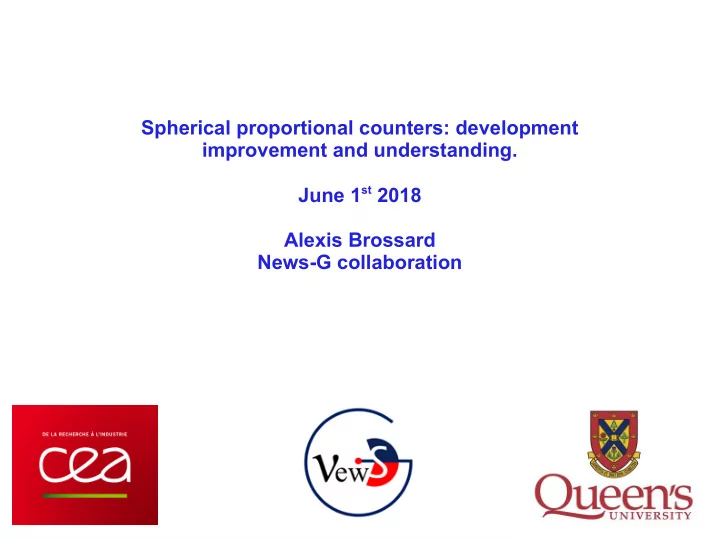

Spherical proportional counters: development improvement and understanding. June 1 st 2018 Alexis Brossard News-G collaboration 1
Outline -Detector Principle -Sensor development -Gas effects -Laser -Results and future 2
Detector principle (5) -1 Particle ionizes gas. -2 Primary electrons drift toward the sensor. -3 Close to the sensor, secondary ion/electron pairs are produced. -4 Signal is induced by the motion of secondary ions. -5 The signal is processed by a pre- amplifier and digitized. -Possibility to use large range of target mass. -Sub-keV energy threshold down to single electron. -Identification of point like energy deposition. -Dark matter search -Neutrino physics 3
Detector principle Rise time ( 4
Detector principle 30 cm diameter sphere. Gas circulation and filtration Residual gas analyser. 2 mm sensor. 98% Ar + 2% CH 4 at 500 mbar Calibration: Americium/Beryllium 55 Fe 37 Ar Solid state laser 5
Sensor development Single electrode sensor: Supporting Rod ▪Metallic Weak Supporting Tip avalanche ▪Insulator Strong Wire avalanche ▪Metallic Core ▪Insulating surface Anode ▪Metallic 6
Sensor development What we expect: Stable with time Homogenous response Charging up Instability Fe 55 X-ray source 90 deg Amplitude 90 deg 180 deg Date 180 deg Inhomogeneous response Time Rise 7 Amplitude
Sensor development The bakelite resistive umbrella Bakelite HV1 HV2 Chemical Formula: (C6-H6-O.C-H2-O)x Thermosetting phenol formaldehyde resin, formed from a condensation reaction of phenol with formaldehyde. S t e e l l a y e r Advantages: ● Bakelite resistivity up to ~ 10^12 � .cm ● Compact and homogenous material Bakelite layer 8
Sensor development 30 cm diameter sphere / Gas mixture: Ar + 2% CH 4 @ 500 mbar Source: 37 Ar Electronic capture released 0.27 or 2.8 keV µ = 20800 µ = 31200 σ/µ =17 % σ/µ =28 % Electric filed lines reaching the lower half of the sensor 9 HV2 = +50 V HV2 = 0 V HV2 = -50 V
Sensor development Rise time vs amplitude distribution Ar-37 events recorded with a 30-cm SPC filled with 500 mbar of Ar + 2 % CH4. Two millimetre ball with HV1 = 2020 V and HV2 = -120 V 2.82 keV σ/µ = 12% 270 eV 10
Other development: Achinos sensor -Amplification is driven by the ball size. Smaller ball gives higher amplification. -Electric field far from the sensor is proportional to sensor radius. In large diameter sphere, a too small sensor gives a too weak electric field at large distance, then electron attachment induce a loss of signal. Achinos sensor E ( r )≈ V 2 r anode r -Amplification is driven by size of each small ball. -Volume electric field is driven by Achinos structure 11
Gas effects 2 % loss of pressure U D A 13 % increase of gain e d u t i l p m A O2 contamination induces electron trapping. Primary electron emitted at large radius are more trapped inducing rise time vs amplitude correlation. This can be avoid using a purifier and circulation. 12
Laser calibration measurements Set-up Analysis Methodology LASER (213 nm) Attenuator PhotoDetector mean no. of electrons µ = 0.08 mean gain <G> = 41.6 ADU From ft: Applications baseline resolution = 4.3 ADU ~ 0.1 e Polya distribution (SER) parameter � ~ 0 with laser: - Drift time and difusion time measurements - Attachment rate measurements - Monitoring of the stability of the detector response - Single electron response parametrizaton - Absolute calibration [no. of PEs] with laser + radioactive source : - Fano factor measurements - W-value measurements
Laser calibration measurements Parametrization of the Single Electron Response (SER) W-value measurement and upper limit on the Fano factor in 500 mbar of Ar + CH 4 (2%) Preliminary <Gain> ~ 41.9 ADU & W ~ 25.9 eV 2820 keV peak @ 4563 ADU
Results and future SEDINE 60 cm detector operating at LSM First results for NEWS-G at LSM: NEWS-G collaboration, Astropart. Phys. 97, 54 (2018), doi: 10.1016/j.astropartphys.2017.10.009 NEWS-G at SNOLAB to be installed during summer 2019. 140 cm detector to be operated at SNOLAB Shielding: 40 cm PE 22 cm VLA Pb 3 cm archaeological lead 15
16
THANK YOU 17
Backup Slides 18
Gas handling system PUMP HP gauge LP gauge RGA IMP S30 37 Ar Gas purifier Circulator GAS BOARD 19
Laser calibration Digitization LASER (Calibox) Scheme of the Set-up Fifth harmonic 1064nm -> 213nm preamplif i er preamplif i er attenuator wheel Band pass f i lter (213 nm) Fiber splitter attenuator PD1 Laser Data - Single electron response parametrization (θ of Polya) - Energy calibration / W-value measurements - Monitoring of the stability of the detector response over time DAN - Drift and Difusion time measurements Photo detector Photodetector (PD) - Monitoring of the stability of laser - Start Time (in drift time measurements) 20
Gas effects Amplitude vs rise time distribution before and after O 2 injection: O2 contamination induces electron trapping. Primary electron emitted at large radius are more trapped inducing rise time vs amplitude correlation. This can be avoid using a purifier and circulation. 21
Influence of HV on second electrode 22
Recommend
More recommend